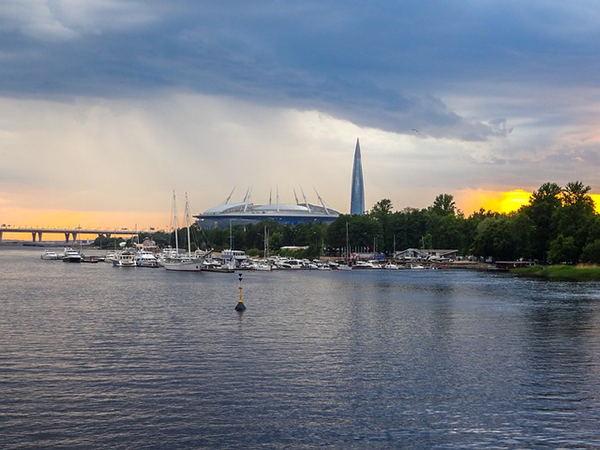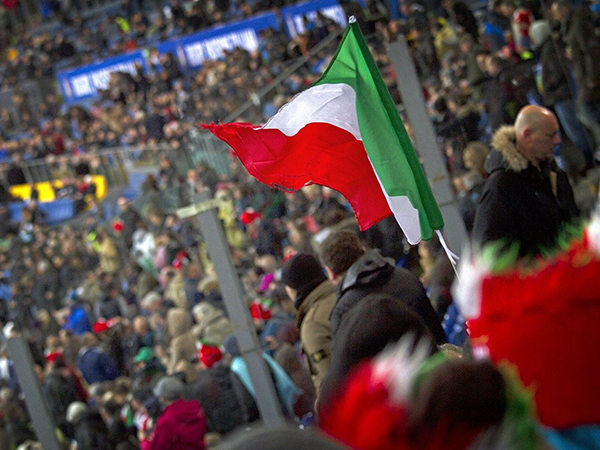The coronavirus pandemic forced the postponement of UEFA’s Euro 2020 soccer tournament. The event has returned a year later, though, and European national teams have been competing in front of crowds. Here are the latest Euro 2020 capacity rules and event restrictions.
Euro 2020 Capacity Guarantees
According to the AP, UEFA set a goal for each stadium to host fans at least 25% capacity. This move led UEFA to drop Dublin and Bilbao from its list of 12 hosts. Organizers added Seville as a host and gave more games to London and St. Petersburg to make up for the lack of a twelfth host.
Euro 2020 Event Restrictions
UEFA’s official guidelines state, “Each ticket holder will be assigned a dedicated 30-minute entry time slot to arrive at the stadium. You’ll also need to wear a face mask at all times. Other measures may include temperature checks or COVID-19 rapid tests, but every stadium is a little bit different.”
Each stadium’s capacity is a little bit different, too, ranging from 100% to 20%. Here’s a look at the capacity for each Euro 2020 event.
Budapest
Hungary is the only country to allow full stadium capacity for all of Euro 2020. According to the Independent, Hungary’s government bought vaccines from Russia and China and vaccinated 5.3 million of its 9.8 million citizens ahead of the event. Official guidelines stipulate that fans must show proof of vaccination or a negative Covid test to enter Puskas Arena.
Players clearly thought the opportunity to play in front of 61,000-plus home fans was a special one.
London
London’s Wembley Stadium will host the finals and semifinals of Euro 2020, in addition to group stage matches. Those earlier matches could host 45,000 fans – 50% of the venue’s capacity – but final rounds can host 60,000 fans (75%), per the BBC.
The publication says that the British government is allowing this high capacity as part of its “Events Research Programme,” even as the nation slightly delays its full reopening. (Check out our breakdowns on this program here and here.)
Copenhagen
Fans arrived in Denmark just as the nation began easing Covid restrictions, Firstpost says. The opening matches at Parken Stadium hosted 16,000 fans, about 45% of capacity. However, capacity increased to 25,000 (66%) for subsequent contests. Additionally, the nation is phasing out Covid passports and mask requirements.
Baku
Olympic Stadium in Baku, Azerbaijan, hosted 34,450 fans, 50% of its normal capacity, according to Reuters. However, organizers limited attendance to fans from the two participating countries.
Azerbaijan did not qualify for the tournament, so games between two faraway nations saw slim crowds, while games featuring nearby nations generated sizeable interest, BBC Sports’ Dafydd Pritchard says.
Bucharest
Veteran European sports journalist Emanuel Rosu says Romania’s sports minister increased capacity at Bucharest’s Arena Nationala to 50% just before Euro 2020 began. This move allowed the venue to welcome up to 27,500 spectators.
St. Petersburg
The Moscow Times says St. Petersburg’s Gazprom Arena hosted fans at 50% capacity for its Euro 2020 contests – a crowd of 34,000. The publication adds that the city has tightened other Covid capacity restrictions and mask rules to account for the influx of travelers.

Amsterdam
Per Reuters, 16,000 fans could attend games at Amsterdam’s Johan Cruijff Arena, up from a previously planned limit of 12,000. This new figure represented just over 31% of capacity.
Yet some fans have had trouble attending games in Amsterdam. According to the Mirror, Denmark and Wales are both not on the Netherlands’ list of safe countries, meaning travelers from there must quarantine upon entry.
However, according to the BBC, citizens of one European Union nation may visit another EU country for up to 12 hours before leaving. So, ahead of a Denmark-Wales match, Danish supporters were able to enter Holland, while travelers from Wales – no longer part of the EU – were not.
Seville
UEFA added Seville as a host site after Bilbao could not guarantee up to 25% capacity. Seville’s La Cartuja Stadium allowed 30% capacity, per a UEFA announcement. Seville’s addition allowed Spain to still host matches.
Rome
Reuters says Rome’s Stadio Olimpico hosted fans at 25% capacity – around 18,000 fans. ESPN says Italy’s opening win, attended by 12,916 fans, was the largest spectator event in Italy since the pandemic began.

Glasgow
Hampden Park welcomed 12,000 fans, or 23% of its capacity, and the Scottish government set up a fan zone to seat an additional 3,000 spectators, per the BBC.
Munich
Munich’s Allianz Arena hosted matches at 20% capacity – with 14,000 total fans – according to Reuters.
Bavarian State Premier Markus Soeder said, “We looked at it carefully. This could be a pilot and test for other professional sports. It is an outstanding test.”
This capacity was the lowest of the tournament.
Despite UEFA’s goal that each host site open to 25% capacity, “leaving out a key country like Germany, which will host Euro 2024, and a stadium like the one in Munich, which will host the 2023 Champions League final, always seemed unlikely,” the AP says.
Starting in August, some of our content will become subscriber-exclusive. This move will help us continue to grow and give our subscribers more insider advice, insights, and networking opportunities. Our newsletter, the IIFXtra, will send you a mix of free and exclusive content as soon as we publish it. Sign up for the IIFXtra below and learn more about subscribing here.
[mailmunch-form id=”1036259″]

